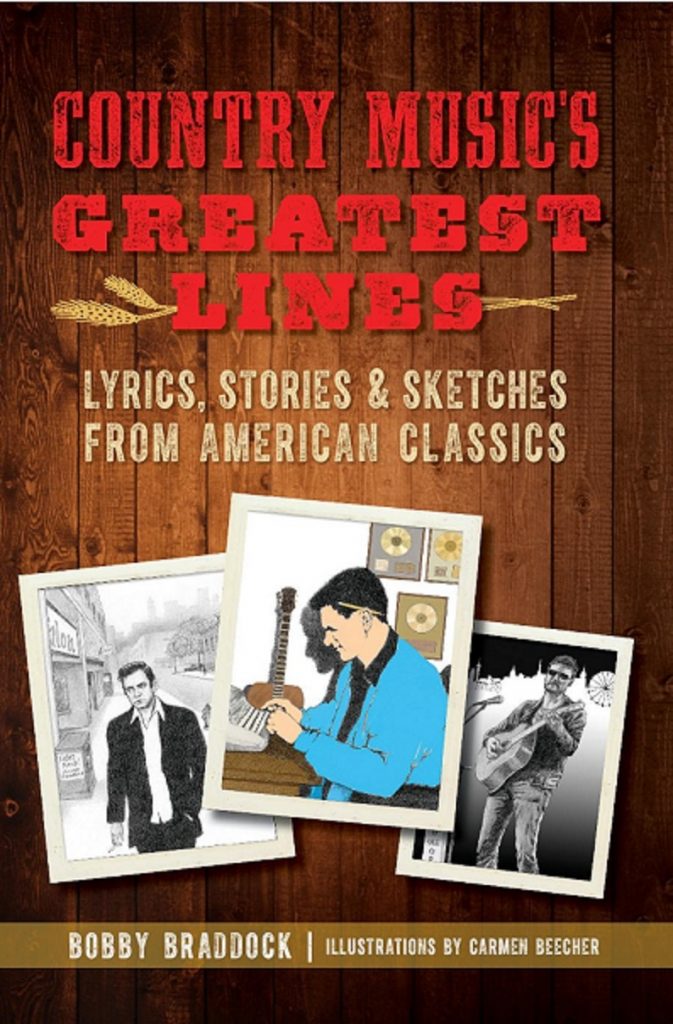Book Review: ‘Country Music’s Greatest Lines: Lyrics, Stories & Sketches From American Classics’ By Bobby Braddock
Read memorable passages from country's classic hits...

We’ve all experienced the earworm effect of a catchy tune, one that can occupy your brain recesses for any number of endearing –- or maddening, depending on the song – days. But occasionally, just a couple lines from a song can also exact that “can’t-get-it-out-of-my-head” feeling, where you find yourself repeating the same refrain from a favorite song. Those lines can be amazingly clever or humorous, contain an interesting wordplay or simply convey a previously undiscovered truth. Whatever the case, they captivate us just as profoundly as the entire song.
Country Music Hall of Fame songwriter Bobby Braddock takes that notion and expertly runs with it in his new book, Country Music’s Greatest Lines: Lyrics, Stories & Sketches From American Classics, featuring illustrations by artist Carmen Beecher. In the book, Braddock devises a novel approach to songwriting analysis. Rather than delving into the complete tune, like so many “Story Behind the Song” works, Braddock concentrates on the memorable lines from some of country’s all-time greatest hits. As he explains in the Author’s Notes, “I often thought that those attention-getting lines that are an important part of country hits would be an interesting topic for a book.” The book features lyric selections from more than 75 songs, including “The Gambler,” “I Fall to Pieces,” “A Broken Wing,” and “Once a Day.”

Braddock makes this a wonderful read with his incisive side notes for each song, for instance, pointing out the striking imagery of this couplet from Hank Williams’ “I’m So Lonesome I Could Cry”: The silence of a falling star/Lights up a purple sky. Braddock, who’s penned such gems as “He Stopped Loving Her Today,” considered by many the finest country tune ever written, “Time Marches On,” “Golden Ring” and others, has also been privy to a slew of songwriting sessions. He knows first-hand the inspirations behind many legendary songs, and, as foreshadowed in the book’s title, he has the stories to go with them. In the book, he recalls, for example, the day that songwriter Rafe Van Hoy played him a song about a “perfect couple” titled “What’s Forever For,” which became a hit for Michael Martin Murphey. Braddock also recounts a night when he and fellow songwriter Joe Allen hit the town (a pursuit not foreign to most Nashville songsmiths), noting that a remark he made to Allen during the evening inadvertently inspired the lines, When I’m puttin’ on my coat and tie/I’m puttin’ on the one that really loves me. When Allen arrived home, he wrote a song around those lyrics. Producer Billy Sherrill changed “coat and tie” to “my makeup” and the resulting song, “The Midnight Oil,” turned into one of the early hits for Barbara Mandrell. Braddock further shares some personal anecdotes of songwriters Hank Cochran, Whitey Shafer and other equally colorful characters, adding to the book’s historical (and sometimes hysterical) flavor.
Country Music’s Greatest Lines features excerpts of songs spanning the 1940s and 50s up to present day, with key lines from hits by legendary composers as well as such modern masters as Eric Church (“Kill a Word” and three others) and Taylor Swift (“Mine,” “Love Story”). Braddock chose to spotlight only one of his songs, a tune he recorded himself called “Avalanche of Romance,” written with Rafe Van Hoy. In that chapter, he explains that including more of his own material would be “immodest and embarrassing.” But he does shine a special light on songs written by non-traditionalists like Gretchen Peters and Chapin Hartford. For Peters’ “Independence Day,” made famous by Martina McBride, Braddock praises the crucial lines, Roll the stone away/Let the guilty pay/It’s Independence Day. “It became sort of a rallying cry for battered women,” Braddock writes. Hartford’s “Shake the Sugar Tree,” a hit for Pam Tillis, also stood as a strong woman’s anthem, summed up in, You’ve got to tend to what you’ve planted/And if you take my love for granted/ Baby I’ll shake the sugar tree.
Braddock’s acute songwriter’s ear and keen eye for detail make him the ideal choice to author a book with this unusual angle. He selects exactly the right lines for each tune, whether they reflect the wordplay inventiveness of I’m a man of means/By no means, from Roger Miller’s “King of the Road,” or the simple poignancy of this passage from Alan Jackson’s “Remember When,” I remember when the sound of little feet/Was the music we danced to/Week-to-week. We see how stand-alone powerful and effective a few well-crafted lines can be, even when removed from the context of the entire song. But we also learn that our songwriting idols can have, on occasion, the proverbial feet of clay. In one chapter, Braddock spots a syntax error in Hank Williams’ “I Can’t Help It (If I’m Still in Love With You),” stating the example in a self-deprecating, lighthearted manner. Further proof that you can often bend the rules of grammar and still come out a successful songwriter.
Whether you’re a serious historian or simply an avid country music fan, you’ll want to put Country Music’s Greatest Lines on your “must read” list.


